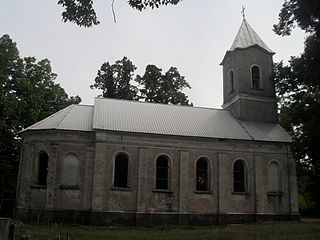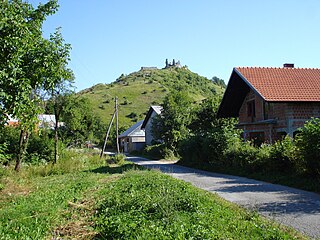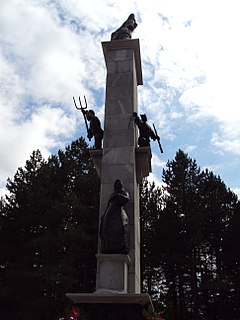 W
WLika is a traditional region of Croatia proper, roughly bound by the Velebit mountain from the southwest and the Plješevica mountain from the northeast. On the north-west end Lika is bounded by Ogulin-Plaški basin, and on the south-east by the Malovan pass. Today most of the territory of Lika is part of Lika-Senj County. Josipdol, Plaški and Saborsko are part of Karlovac County and Gračac is part of Zadar County.
 W
WBrotnja is a village in Croatia. It is connected by the D218 highway.
 W
WBruvno is a village in Croatia.
 W
WCerovac is a village in Croatia.
 W
WDabašnica is a village in Croatia.
 W
WDeringaj is a village in Croatia.
 W
WDonja Suvaja is a village in Croatia.
 W
WDonji Srb is a village and former settlement in Croatia.
 W
WDrenovac Osredački is a village in Croatia.
 W
WDuboki Dol is a village in Croatia.
 W
WDugopolje is a village in Croatia.
 W
WGlogovo is a village in Croatia.
 W
WGornja Suvaja is a village in Croatia.
 W
WGornji Srb is a village and former settlement in Croatia.
 W
WGrab is a village in Croatia.
 W
WGračac (pronounced [grǎtʃats] is a town and municipality in the southern part of Lika, Croatia. The municipality is administratively part of Zadar County.
 W
WGubavčevo Polje is a village in Croatia.
 W
WThe Guduscani or Guduscans were a tribe around present day Gacka (Lika), between upper Kupa river and the Dalmatian coast, or the inhabitants around the river Guduča near Zadar, a Croatian tribe, i.e. the people of the Bribir region. It has been assumed, that they were part of the Vandals, Goths or Croats. However, the view that the Guduscans were Goths is not widely accepted, their state was in Italy and it ceased to exist in the 6th century, while their presence in the former Roman province of Dalmatia was not dominant. The German historian Josef Baptist von Weiß (1820–1899) thought that the Guduscani were descendants of the East Germanic Vandals.
 W
WKaldrma is a village in Croatia.
 W
WKijani is a village in Croatia.
 W
WKom is a village in Croatia.
 W
WKrbava is a historical region located in Mountainous Croatia and a former Catholic bishopric (1185–1460), precursor of the diocese of Modruš an present Latin titular see.
 W
WKunovac Kupirovački is a village in Croatia.
 W
WKupirovo is a village in Croatia. It is connected by the D218 highway.
 W
WThe Lika cap, also known as kićanka ("tassel"), is an important cultural symbol of the Lika region in Croatia, part of the Lika national costume, traditionally worn by local Croats and Serbs. The cap is cylinder-shaped with a flat top in red colour and the sides are black, and a black tassels often hangs down the back.
 W
WThe Lika is a breed of sheep from the mountainous regions of Lika and Gorski Kotar in Croatia.
 W
WLika-Krbava County was a historic administrative subdivision (županija) of the Kingdom of Croatia-Slavonia. Croatia-Slavonia was an autonomous kingdom within the Lands of the Crown of Saint Stephen (Transleithania), the Hungarian part of the dual Austro-Hungarian Empire. Its territory is now in southwestern Croatia. Lika and Krbava are the names of two valleys in the county. The capital of the county was Gospić.
 W
WMazin is a village in Croatia. It is connected by the D218 highway.
 W
WModruš is a village, former bishopric and current Latin Catholic titular see in the mountainous part of Croatia, located south of its municipality's seat Josipdol, on the easternmost slopes of Velika Kapela mountain, in northern Lika.
 W
WNeteka is a village in Croatia. It is connected by the D218 highway.
 W
WOmsica is a village in Croatia.
 W
WOsredci is a village in Croatia.
 W
WPlješivica or Plješevica, also called Lička Plješevica, is a mountain in Croatia and on the border with Bosnia and Herzegovina, part of the Dinaric Alps. It stretches in the direction north–south, and it extends from the mountain pass that separates it from Mala Kapela, along the Krbava field to the west and the Una River canyon to the east, and ending near Gračac where it touches on Velebit.
 W
WRudopolje Bruvanjsko is a village in Croatia.
 W
WThe Seressaner were an Habsburg military police unit in Lika, Croatian Military Frontier. The name is derived from Saracens.
 W
WSrb is a village located in the southeastern part of Lika, in Croatia, till 2011 administratively divided into Donji Srb and Gornji Srb. Srb lies in the Una River valley, on the road from Donji Lapac to Knin, and is east of Gračac. It is currently part of the Gračac municipality and the Zadar County.
 W
WTiškovac Lički is a village in Croatia.
 W
WTomingaj is a village in Croatia. Nikola Tesla at one point lived in Tomingaj.
 W
WThe Tržan Castle is a ruined medieval castle above the village of Modruš in the northern part of historical Lika region, central Croatia. Before the administrative seat of the former Modruš County, it is today a ruin in the Josipdol Municipality in the southern part of the Karlovac County.
 W
WThe Una is a border river between Bosnia and Herzegovina and Croatia and a right tributary of the Sava river. It is part of the Black Sea drainage basin, and its watershed has a size of 10.200 km², of which 8.080 km² belongs to Bosnia and Herzegovina, and 2.120 km² to Croatia. The total length of the river is 212 km. The source of the river is located in the town of Donja Suvaja in Croatia, and its mouth is located near the town of Jasenovac, on the border with Bosnia. The largest right tributaries are the Krka, Unac, Krušnica and Sana rivers, and the largest left tributary is the Klokot river. Its longest headwater is the Unac river. The largest and most important city located on the river is Bihać. Other, smaller cities and towns are Bosanska Krupa, Novi Grad and Kostajnica. The river is characterized by a multitude of waterfalls, rapids, karst springs and relatively untouched nature. A large part of the upper river is part of the Una National Park.
 W
WVelebit is the largest, though not the highest, mountain range in Croatia. The range forms a part of the Dinaric Alps and is located along the Adriatic coast, separating it from Lika in the interior. Velebit begins in the northwest near Senj with the Vratnik mountain pass and ends 145 km to the southeast near the source of the Zrmanja river northwest of Knin.
 W
WVučipolje is a village in Croatia. It is connected by the D1 road.
 W
WZaklopac is a village in Croatia.